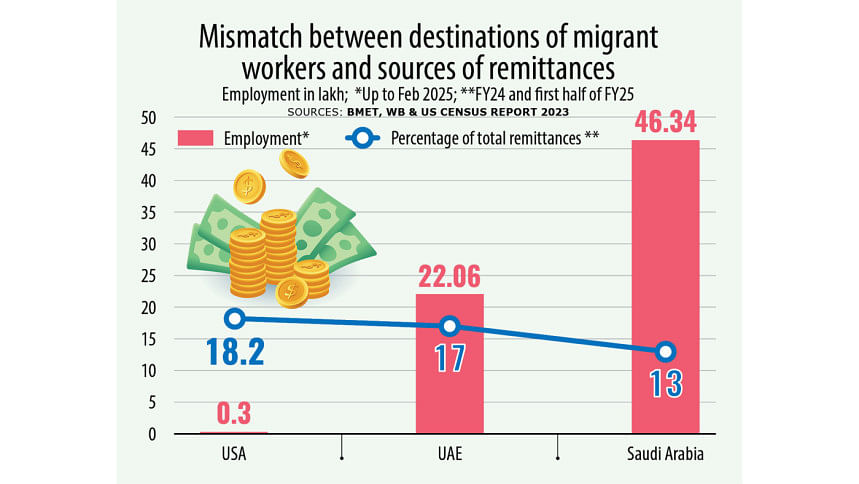WB finds mismatch in migration and remittance trends

While Saudi Arabia remains the top destination for Bangladeshi migrant workers, it is the United States (US) and the United Arab Emirates (UAE) that are leading in remittance contributions despite hosting comparatively smaller migrant populations.
This striking mismatch is at the heart of the World Bank's newly released "Bangladesh Development Update", which reports a record-breaking 27.6 percent year-on-year increase in remittance inflows during the first eight months of FY25.
According to the Bureau of Manpower, Employment and Training (BMET), over 46.34 lakh Bangladeshi workers are currently residing in Saudi Arabia.
The UAE follows suit with around 22.06 lakh workers. Yet, Saudi Arabia accounted for less than 13 percent of total remittance inflows, while the UAE surpassed it with around 17 percent.
The US, home to just over 3.04 lakh Bangladeshi migrants according to the US Census Bureau as of 2023, topped all countries with an 18.2 percent share.
The World Bank also warned that prolonged visa suspensions, economic instability in host countries, and over-reliance on a few destinations could put future remittance inflows at risk.
It attributes the remittance surge to several factors – the crawling peg exchange rate introduced in May 2024, a significant depreciation of the taka, and the 2.5 percent government incentive on use of official remittance channels.
Shariful Hasan, associate director of the BRAC Migration Programme and Youth Platform, also endorsed this view.
"The high exchange rates of the US dollar and pound sterling against the taka have made sending money legally more appealing for migrants," he said.
"This gap between where our people go and where the money comes from has grown too large to ignore," he added.
"It shows that our workers in the Gulf, particularly in Saudi Arabia, are increasingly engaging in low-wage, low-productivity jobs, whereas fewer but more skilled migrants – mostly professionals in the United Kingdom and US – are sending back more."
Despite this shift, 74.5 percent of new migrant outflows in the first half of FY25 were still headed to Saudi Arabia, although total outflows declined by 26.9 percent due to stricter visa regimes and policy shifts across Gulf countries, according to the World Bank's report.
"This is not sustainable," Shariful warned.
"We are exporting labour where it's cheap, but the remittance return is shrinking. A smarter migration strategy focused on skill and destination diversity is urgently needed," he said.
Speaking to The Daily Star, Mustafizur Rahman, distinguished fellow at the Centre for Policy Dialogue, said they questioned the Bangladesh Bank governor on the declining remittance from Saudi Arabia despite the large number of migrant workers there.
"The trend is continuing now. Earlier, remittance flows may have been affected as money used to come through informal channels like hundi, but that has mostly stopped," he said.
"It cannot simply be explained by the number of migrant workers in Saudi Arabia. The fluctuation in remittance flow from the country is concerning," he said.
"Bangladesh Bank should rigorously investigate whether there is any leakage in the system, policy weaknesses, or if any vested quarters are involved," he added.
He also noted that the rise in remittance from the US was not entirely new, as it previously ranked second.
"Why remittance from the UAE has increased is also a matter that warrants investigation," Rahman said.
However, migration economist Prof Mohammad Jalal Uddin cautioned that several short-term drivers were behind the remittance boom.
He explained that while the spike in remittance is impressive, only a few temporary factors are driving it.
"One reason is that many irregular migrants are sending most of their income home as their family members still live in Bangladesh," Jalal said.
"Another is the steep rise in work permit costs in Saudi Arabia as what once cost 300 to 400 riyals now ranges between 3,000 and 4,000 riyals, and in some cases even 8,000 riyals. This could lead to a future drop in remittances from the Gulf," he added.
For long-term stability, Jalal urged the government to negotiate bilateral agreements that ensure fair wages and labour rights, and to prioritise skilled migration over unskilled outflows.

 For all latest news, follow The Daily Star's Google News channel.
For all latest news, follow The Daily Star's Google News channel. 



Comments